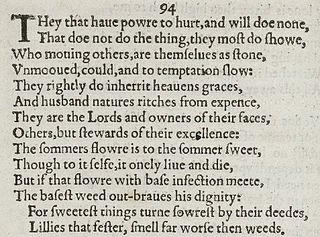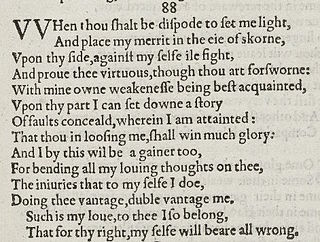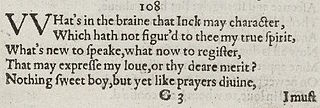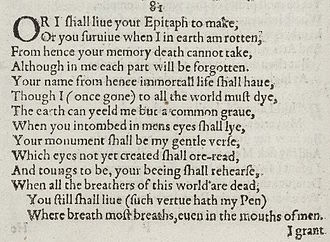
Sonnet 94 is one of 154 sonnets written by the English playwright and poet William Shakespeare. It is a member of the Fair Youth sequence, in which the poet expresses his love towards a young man.

Sonnet 27 is one of 154 sonnets published by William Shakespeare in a quarto titled Shakespeare's Sonnets in 1609. It is a part of the Fair Youth group of sonnets, and the first in a group of five sonnets that portray the poet in solitude and meditating from a distance on the young man. A theme of the first two of the group regards the night and restlessness, which is a motif also found in the sonnets of Petrarch.

Sonnet 28 is one of 154 sonnets published by the English playwright and poet William Shakespeare in 1609. It is a part of what is considered the Fair Youth group, and part of another group that focuses on the solitary poet reflecting on his friend. There is a theme of night and sleeplessness, which is a traditional motif that also occurs in Petrarchan sonnets.

Sonnet 141 is the informal name given to the 141st of William Shakespeare's 154 sonnets. The theme of the sonnet is the discrepancy between the poet's physical senses and wits (intellect) on the one hand and his heart on the other. The "five wits" that are mentioned refer to the mental faculties of common sense, imagination, fantasy, instinct, and memory. The sonnet is one of several in which the poet's heart is infatuated despite what his eyes can see.

Sonnet 75 is one of 154 sonnets written by the English playwright and poet William Shakespeare. It is a member of the Fair Youth sequence, in which the poet expresses his love towards a young man.

Sonnet 76 is one of 154 sonnets published by the English playwright and poet William Shakespeare in 1609. It's a member of the Fair Youth sequence.

Sonnet 119 is one of 154 sonnets written by the English playwright and poet William Shakespeare. It's a member of the Fair Youth sequence, in which the poet expresses his love towards a young man.

Sonnet 79 is one of 154 sonnets published by the English playwright and poet William Shakespeare in 1609. It is part of the Fair Youth sequence, and the second sonnet of the Rival Poet sequence.

Sonnet 80 is one of 154 sonnets published by the English playwright and poet William Shakespeare in 1609. It is part of the Fair Youth sequence, and the third sonnet of the Rival Poet sequence.

Sonnet 88 is one of 154 sonnets published in 1609 by the English playwright and poet William Shakespeare. It's one of the Fair Youth sequence.

Sonnet 82 is one of 154 sonnets published by William Shakespeare in a quarto titled Shakespeare's Sonnets in 1609. It is a part of the Fair Youth series of sonnets, and the fifth sonnet of the Rival Poet group.

Sonnet 83 is one of 154 sonnets published by William Shakespeare in a quarto titled Shakespeare's Sonnets in 1609. It is a part of the Fair Youth group of sonnets, and the sixth sonnet of the Rival Poet group.

Sonnet 84 is one of 154 sonnets published by the English playwright and poet William Shakespeare in 1609. It's part of the Fair Youth sequence, and the seventh sonnet of the Rival Poet group.

Sonnet 85 is one of 154 sonnets published by the English playwright and poet William Shakespeare in 1609. It's part of the Fair Youth sequence, and the eighth sonnet of the Rival Poet group.

Sonnet 86 is one of 154 sonnets first published by the English playwright and poet William Shakespeare in the Quarto of 1609. It is the final poem of the Rival Poet group of the Fair Youth sonnets in which Shakespeare writes about an unnamed young man and a rival poet competing for the youth's favor. Though the exact date of its composition is unknown, it has been suggested that the Rival Poet series may have been written between 1598 and 1600.

Sonnet 90 is one of 154 sonnets written by the English playwright and poet William Shakespeare. It is a member of the Fair Youth sequence, in which the poet expresses his love towards a young man.

Sonnet 96 is one of 154 sonnets written by the English playwright and poet William Shakespeare. It is a member of the Fair Youth sequence.

Sonnet 108 is one of 154 sonnets written by the English playwright and poet William Shakespeare. It is a member of the Fair Youth sequence, in which the poet expresses his love towards a young man.

Sonnet 111 is one of 154 sonnets written by the English playwright and poet William Shakespeare. It is a member of the Fair Youth sequence, in which the poet expresses his love towards a young man.
Sonnet 120 is one of 154 sonnets written by the English playwright and poet William Shakespeare. It's a member of the Fair Youth sequence, in which the poet expresses his love towards a young man.





















